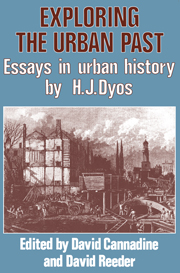Book contents
- Frontmatter
- Contents
- Acknowledgements
- Introduction: H. J. Dyos and the urban process, by David Reeder
- Part One The Urbanising World
- Part Two Transport and Urban Transformation
- Part Three The Urban Fabric
- Conclusion Urban history in the United Kingdom: the ‘Dyos phenomenon’ and after, by David Cannadine
- Appendix: A bibliography of the published writings of H. J. Dyos
- Notes
Conclusion - Urban history in the United Kingdom: the ‘Dyos phenomenon’ and after, by David Cannadine
Published online by Cambridge University Press: 03 February 2010
- Frontmatter
- Contents
- Acknowledgements
- Introduction: H. J. Dyos and the urban process, by David Reeder
- Part One The Urbanising World
- Part Two Transport and Urban Transformation
- Part Three The Urban Fabric
- Conclusion Urban history in the United Kingdom: the ‘Dyos phenomenon’ and after, by David Cannadine
- Appendix: A bibliography of the published writings of H. J. Dyos
- Notes
Summary
During the late 1960s and early 1970s, in Britain as in the United States, there was a marked proliferation of the sub-specialisms within the realms of historical scholarship - social history, oral history, women's history, family history, and so on. But of all Clio's new offsprings, none was so exuberantly expansive, nor so closely identified with one man (Jim Dyos) and one university (Leicester) as was urban history. Even social history, which was urban history's nearest rival among the burgeoning new fields of historical interest, was diffuse in its organisation and divided in its administration by comparison, with a wide proliferation of societies, series, conferences and journals. By contrast, urban history seemed a model of centralised organisation. As Bruce Stave rightly noted at the beginning of his interview with Jim Dyos, ‘In terms of British urban history, all roads seem to lead to you and to the University of Leicester.’
Indeed, the supreme paradox of urban history in the United Kingdom was that, as long as Dyos lived, it combined the maximum of organisational centralisation with the minimum of intellectual dogmatism - a position almost exactly the opposite of that which prevailed in the United States, where the New Urban History was being developed at the same time. Zealous and indefatigable entrepreneurship was allied with a complete lack of scholarly imperialism or doctrinaire exclusiveness. It was this blending of a coherent and energetic organisation with a tolerant and encouraging intellectual milieu, which made the urban history explosion both the most spectacular and the most appealing of the historical booms in Britain during the late 1960s and 1970s.
- Type
- Chapter
- Information
- Exploring the Urban PastEssays in Urban History by H. J. Dyos, pp. 203 - 222Publisher: Cambridge University PressPrint publication year: 1982
- 7
- Cited by

